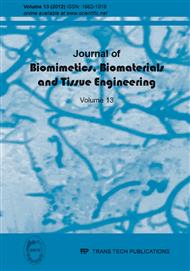[1]
U. Kamachi Mudali, T. M. Sridhar and Baldev Raj, Corrosion of bio implants, Sadhana, 28 (3-4), 2003, 601-637.
DOI: 10.1007/bf02706450
Google Scholar
[2]
T. Hanawa, Metal ion release from metal implants, Mater. Sci. Eng. C, 24 (6-8), 2004, 745-752.
Google Scholar
[3]
G. Herting, I. Odnevall Wallinder and C. Leygraf, Metal release rate from AISI 316 stainless steel and pure Fe, Cr and Ni into a synthetic biological medium- a comparison, J. Environ. Monit., 10 (2008) 1092-1098.
DOI: 10.1039/b805075a
Google Scholar
[4]
A. Balamurugan, S. Rajeswan, G. Balossier, A. H. S. Rebelo, J. M. F. Ferreira, Corrosion aspects of metallic implants - An overview, Mater. Corros., 59, 11 (2008) 855-869.
DOI: 10.1002/maco.200804173
Google Scholar
[5]
Product Data Bulletin 316/316L Stainless Steel-B-11-01-99, (1999) 1-5.
Google Scholar
[6]
Y.S. Kim, Y.R. Yoo, C.G. Sohn, K.T. Oh, K.N. Kim, J.H. Yoon and H.S. Kim, Role of alloying elements on the cytotoxic behaviour and corrosion of austenitic stainless steels, Mater. Sci. Forum, 475-479 (2005) 2295-2298.
DOI: 10.4028/www.scientific.net/msf.475-479.2295
Google Scholar
[7]
International Agency for Research on Cancer 1990 IARC monographs on the evaluation of carcinogenic risks to humans. Chromium, Nickel and Welding, Vol. 49 (IARC, Lyon, France), 1990, p.104, 310.
DOI: 10.1016/0278-6915(91)90150-6
Google Scholar
[8]
K. Yang and Y. Ren, Nickel-free austenitic stainless steels for medical applications, Sci. Technol. Adv. Mater., 11, (2010) 1-13.
Google Scholar
[9]
K.M. Veerabadran, U. Kamachi Mudali, K.G.M. Nair and M. Subbaiyan, Improvements in localized corrosion resistance of nitrogen ion implanted type 316L stainless steel orthopaedic implant devices, Mater. Sci. Forum, 318-320, (1999) 561-568.
DOI: 10.4028/www.scientific.net/msf.318-320.561
Google Scholar
[10]
J. Gawroński, Adhesion of composite carbon/hydroxyapatite coatings on AISI 316L medical steel, Archives of Foundry Engineering, 9, 3 (2009) 235-242.
Google Scholar
[11]
N. Eliaz,T. M. Sridhar, U. Kamachi Mudali and Baldev Raj, Electrochemical and electrophoretic deposition of hydroxyapatite for orthopaedic applications, Surf. Eng., 21, 3 (2005) 1-5.
DOI: 10.1179/174329405x50091
Google Scholar
[12]
S.R. Paital and N.B. Dahotre, Calcium phosphate coatings for bio-implant applications: materials, performance factors and methodologies, Mater. Sci. Eng. R 66, (2009), 1-70.
DOI: 10.1016/j.mser.2009.05.001
Google Scholar
[13]
M.I. Espitia-Cabrera, H.D. Orozco-Hernández, M.A. Espinosa-Medina, L. Martinez and M.E. Contreras-Garcia, Comparative study of corrosion in physiological serum of ceramic coatings applied on 316L stainless steel substrate, Adv. Mat. Res., 68 (2009).
DOI: 10.4028/www.scientific.net/amr.68.152
Google Scholar
[14]
G. Vargas, P. Mondragón, G. Garcia, H.H. Rodriguez, A. Chávez and D.A. Cortés, EPD-Sintering of hydroxyapatite, porcelain and wollastonite on 316L stainless steel, Key Eng. Mater., 314, (2006) 263-268.
DOI: 10.4028/www.scientific.net/kem.314.263
Google Scholar
[15]
K. Hrabovská, J. Podjuklová, K. Barčova, L. Dobrovoská and K. Pelikánová, Vitreous enamel coating on steel substrates, Solid State Phenomena, 147-149 (2009) 856-860.
DOI: 10.4028/www.scientific.net/ssp.147-149.856
Google Scholar
[16]
N. Ramesh Babu, Sushant Manwatkar, K. Prasada Rao and T. S. Sampath Kumar, Bioactive coatings on 316L stainless steel implants, Trends Biomater. Artif. Organs., 17, 2 (2004) 43-47.
Google Scholar
[17]
M. Britchi, M. Olteanu, G. Jitianu, M. Branzei, D. Gheorghe and P. Nita, Vitroceramic coatings on metallic suports with biomedical applications, Int. J. Mater. Prod. Technol., 15, 6 (2000) 446-457.
DOI: 10.1504/ijmpt.2000.001257
Google Scholar
[18]
M. Britchi, M. Olteanu, G. Jitianu, M. Branzei, D. Gheorghe and P. Nita, Preparation and characterization of biocompatible vitroceramic-metal systems for applications in medicine, Surf. Eng., 17, 4 (2001) 313-316.
DOI: 10.1179/026708401101517935
Google Scholar
[19]
M. Britchi, M. Olteanu and N. Ene, Optical microscopy and microhardness characterization of some biovitroceramics used as coatings on titanium, Int. J. Mater. Prod. Technol., 25, 4 (2006) 267-280.
DOI: 10.1504/ijmpt.2006.008883
Google Scholar
[20]
A. Appen, Chimya Stekla, Leningrad, 1974, pp.193-195.
Google Scholar
[21]
M. Britchi, M. Olteanu and N. Ene, Obtaining and characterization of biovitroceramic coatings on the metallic substrate made from 316L austenitic steel with application in implantology, Int. J. Arts Sci., 4, 19 (2011) 215-225.
DOI: 10.4028/www.scientific.net/jbbte.13.19
Google Scholar
[22]
M. Britchi, N. Ene, M. Olteanu and C. Radovici, Titanium diffusion coatings on austenitic steel obtained by the pack cementation method, J. Serb. Chem. Soc, 74, 2 (2009) 203-212.
DOI: 10.2298/jsc0902203b
Google Scholar
[23]
M. Britchi, N. Ene, M. Olteanu, E. Vasile, P. Nita and E. Alexandrescu, Surface properties of 316L austenitic steel improved by simultaneous diffusion of titanium and aluminium, Defect Diffus. Forum, 297-301, (2010) 1-7.
DOI: 10.4028/www.scientific.net/ddf.297-301.1
Google Scholar
[24]
M. Britchi, Mircea Olteanu, Niculae Ene and Petru Nita, Diffusion layers with Ti and Ti+Al formed on 316L austenitic steel by a pack cementation procedure, Defect Diffus. Forum, 312-315 (2011) 13-19.
DOI: 10.4028/www.scientific.net/ddf.312-315.13
Google Scholar
[25]
R. Gopal, C. Calvo, J. Ito and W. K. Sabine, Crystal structure of synthetic Mg-Whitlockite, Ca18Mg2H2(PO4)14, Can. J. Chemistry, 52 (1974) 1155-1164.
DOI: 10.1002/chin.197425016
Google Scholar
[26]
M.S. Sader, E.L. Moreira, V.C.A. Moraes, J.C. Araújo, R.Z. LeGeros and G.A. Soares, Rietveld refinement of sintered magnesium substituted calcium apatite, Key Eng. Mater., 396-398 (2009) 277-280.
DOI: 10.4028/www.scientific.net/kem.396-398.277
Google Scholar
[27]
A. Ito and R.Z. LeGeros, Magnesium- and Zinc-substituted beta-tricalcium phosphates as potential bone substitute biomaterials, Key Eng. Mater., 377 (2008) 85-98.
DOI: 10.4028/www.scientific.net/kem.377.85
Google Scholar


